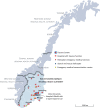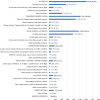Dispatch accuracy of physician-staffed emergency medical services in trauma care in south-east Norway: a retrospective observational study
- PMID: 34876197
- PMCID: PMC8650530
- DOI: 10.1186/s13049-021-00982-3
Dispatch accuracy of physician-staffed emergency medical services in trauma care in south-east Norway: a retrospective observational study
Abstract
Background: Selection of incidents and accurate identification of patients that require assistance from physician-staffed emergency medical services (P-EMS) remain essential. We aimed to evaluate P-EMS availability, the underlying criteria for dispatch, and the corresponding dispatch accuracy of trauma care in south-east Norway in 2015, to identify areas for improvement.
Methods: Pre-hospital data from emergency medical coordination centres and P-EMS medical databases were linked with data from the Norwegian Trauma Registry (NTR). Based on a set of conditions (injury severity, interventions performed, level of consciousness, incident category), trauma incidents were defined as complex, warranting P-EMS assistance, or non-complex. Incident complexity and P-EMS involvement were the main determinants when assessing the triage accuracy. Undertriage was adjusted for P-EMS availability and response and transport times.
Results: Among 19,028 trauma incidents, P-EMS were involved in 2506 (13.2%). The range of overtriage was 74-80% and the range of undertriage was 20-32%. P-EMS readiness in the event of complex incidents ranged from 58 to 70%. The most frequent dispatch criterion was "Police/fire brigade request immediate response" recorded in 4321 (22.7%) of the incidents. Criteria from the groups "Accidents" and "Road traffic accidents" were recorded in 10,875 (57.2%) incidents, and criteria from the groups "Transport reservations" and "Unidentified problem" in 6025 (31,7%) incidents. Among 4916 patient pathways in the NTR, 681 (13.9%) could not be matched with pre-hospital data records.
Conclusions: Both P-EMS availability and dispatch accuracy remain suboptimal in trauma care in south-east Norway. Dispatch criteria are too vague to facilitate accurate P-EMS dispatch, and pre-hospital data is inconsistent and insufficient to provide basic data for scientific research. Future dispatch criteria should focus on the care aspect of P-EMS. Better tools for both dispatch and incident handling for the emergency medical coordination centres are essential. In general, coordination, standardisation, and integration of existing data systems should enhance the quality of trauma care and increase patient safety.
Keywords: Dispatch; Physician-staffed emergency medical services; Pre-hospital trauma care; Triage.
© 2021. The Author(s).
Conflict of interest statement
Martin Samdal (MS) is a research fellow with Norwegian Air Ambulance Foundation (NAAF) and a consultant anaesthesiologist working both at the Department of Anaesthesiology and Intensive care and the Air Ambulance Department, Drammen Hospital, Vestre Viken Hospital Trust. Kjetil Thorsen (KT) is a senior researcher at NAAF. Ola Græsli (OG) is a paramedic and ICT-advisor at the Pre-hospital division, Oslo University Hospital. Mårten Sandberg (MSb) and Marius Rehn (MR) are consultant anaesthesiologists working at the Pre-hospital Division, Air Ambulance Department, Oslo University Hospital. Rehn is also a senior researcher at NAAF and an associate professor at the University of Stavanger. None of the authors have any other relationships, financial or personal, to disclose that could have inappropriately influenced this study.
Figures





References
-
- Franschman G, Verburg N, Brens-Heldens V, Andriessen TMJC, Van der Naalt J, Peerdeman SM, Valk JP, Hoogerwerf N, Greuters S, Schober P, et al. Effects of physician-based emergency medical service dispatch in severe traumatic brain injury on prehospital run time. Injury-Int J Care Injured. 2012;43(11):1838–1842. doi: 10.1016/j.injury.2012.05.020. - DOI - PubMed
Publication types
MeSH terms
LinkOut - more resources
Full Text Sources
Medical

